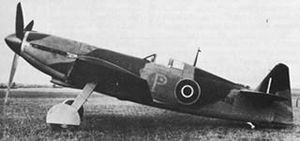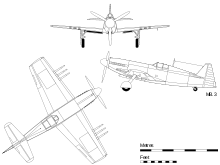- Martin-Baker MB 3
-
MB 3 Role Fighter Manufacturer Martin-Baker Designer James Martin First flight 31 August 1942 Status Experimental Primary user Royal Air Force (intended) Number built 1 Developed from Martin-Baker MB1
Martin-Baker MB2Variants Martin-Baker MB5 The Martin-Baker MB3 was a British fighter project with six 20mm cannon. The fatal crash of the prototype led to the programme's cancellation.
Contents
Design and development
Using lessons learned from the previous MB1 and MB2, James Martin and Captain Valentine Baker capitalised on the design and construction to develop a new design, the MB3, which was powered by a 2,000 hp Napier Sabre 24-cylinder, H-type engine, driving a de Havilland variable-pitch three-blade propeller.
The MB3 was projected to meet an Air Ministry fighter specification. It was armed with six 20 mm cannon mounted in the wings, each with 200 rounds of ammunition, which made it the most heavily armed fighter in existence at the time. In an effort to ensure the MB3 was capable of a quick turnaround from an operational point of view, the armament installation was easily accessible. Three were ordered to specification F.18/39 which was written for the design.
While retaining the essential characteristics of the earlier designs, MB3 included many new features: the fuselage primary structure was still the round steel tube arrangement, but metal panels had taken the place of wood and fabric of earlier models. The wing construction integrated torsion-box construction and a laminated steel spar, giving a strong and stiff structure with minimum flexing.
The careful attention to detail extended to a Martin-designed pneumatically-controlled undercarriage that was simple, sturdy, effective, and reliable. With the wing flaps also pneumatically operated, the need for hydraulics, with all their attendant operational hazards and maintenance problems, was eliminated. Underwing radiators had the coolant radiator on the starboard and the oil cooler on the port side.
Testing and evaluation
Then listed as "Experimental Aeroplane No.120" and with the serial number R2492, the MB3 was temporarily stationed at 26 OTU (Operational Training Unit - RAF Wing in Buckinghamshire) for trials and first flew on 31 August 1942. The tests were supervised by Group Captain Snaith and observed by, amongst others, Air Vice Marshals Linnell and Burton. Following its successful first flight, undertaken by Capt.Baker, the next series of test flights revealed the MB3 to be highly manoeuvrable and easy to fly. However, on 12 September 1942, the engine failed soon after takeoff and Captain Baker, in an attempt to save the aircraft while executing a difficult forced landing, crashed in a field and was killed.
The Unit Report states: "Capt. Baker had just got airborne, when he had immediate loss of power. In trying to save the aircraft he made a forced landing in a field but hit a tree stump and was killed."
The subsequent Court of Inquiry found the cause to be "...engine failure due to a broken sleeve drive crank in the engine."
Unsubstantiated reports have also suggested that the Napier Sabre engine used had already been suffering with overheating problems on the ground.
Ground-crewman George Bignall recalled "Although nobody was allowed into the aircraft hangar, we were able to see it during its testing time. It was very fast with Captain Baker flying very close at times, shooting up the runway very low." Of the day of the accident he said "I was doing a modification on dispersals when Captain Baker took off towards Stewkley. I watched him climb then suddenly the engine cut out and he crashed, trying to land."
Civilian John Thornton also witnessed the accident: "Two fields from where Morris and I were harvesting, there was a stack of newly-threshed straw. The MB3 hit this and burst into flame. 'Bunny' Winter, the bailiff of Cold Harbour Farm, beat us to the crash, but we were too late to rescue Captain Baker in the fierce fire."
The Unit Report states that Mr Winter actually managed to remove Capt. Baker's body from the aircraft.
Due to various delays and late delivery, the Ministry considered the design outdated and there was no production order.[1]
Despite the loss of the sole prototype, the MB3 design was not abandoned and Martin decided to design the MB4, powered by a Griffon engine. This project was eventually dropped in favour of an entirely new design, which became the MB5.
Legacy
The MB3 design could have been developed into a good fighter aircraft. Martin felt the personal loss of his best friend and partner and "many consider that it was this painful tragedy that really fired the passionate interest in the safety of aircrews, which was later to become the very pivot of his life." [2] He devoted the remainder of his life to the invention and development of the successful Martin-Baker ejection seats (the company retained the name Martin-Baker as a tribute to their lost co-founder).
Specifications (MB3)
Data from Jane’s Fighting Aircraft of World War II[3] and British Aircraft of World War II[2]
General characteristics
- Crew: one
- Length: 35 ft 4 in (10.77 m)
- Wingspan: 35 ft 0 in (10.7 m)
- Height: 15 ft 0 in (4.5 m)
- Wing area: 262 ft² (24.3 m²)
- Empty weight: 9,233 lb (4,188 kg)
- Loaded weight: 11,497 lb (5,216 kg)
- Max takeoff weight: 12,090 lb (5,484 kg)
- Powerplant: 1 × Napier Sabre 24-cylinder, H-type engine liquid-cooled engine, 2,000 hp (1,745 kW)
Performance
- Maximum speed: 415 mph (668 km/h) at 20,000 ft (6,100 m)
- Range: 1,100 mi (1,770 km)
- Service ceiling: 40,000 ft (12,190 m)
- Rate of climb: 3,800 ft/min (19.3 m/s)
Armament
- Guns: 6× 20 mm Hispano Mk.II cannon
See also
- Related development
- Aircraft of comparable role, configuration and era
References
- Notes
- Bibliography
- Bowyer, Michael J.F. Interceptor Fighters for the Royal Air Force 1935-45. Wellingborough, UK: Patrick Stephens Ltd., 1984. ISBN 0-85059-726-9.
- Green, William. War Planes of the Second World War: Fighters, Volume Two. London, Macdonald & Co. (Publishers) Ltd., 1961.
- Green, William and Gordon Swanborough. WW2 Fact Files: RAF Fighters, Part 2. London: Macdonald and Jane's Publishers Ltd., 1979. ISBN 0-354-01234-7.
- Jane, Fred T. “The Martin-Baker F.18/39.” Jane’s Fighting Aircraft of World War II. London: Studio, 1946. ISBN 1-85170-493-0.
- Teeuwen, Jaap. British Aircraft of World War II: M.B.3. Retrieved: 8 June 2007.
External links
Aircraft designed or produced by Martin-Baker Lists relating to aviation General Aircraft (manufacturers) · Aircraft engines (manufacturers) · Airlines (defunct) · Airports · Civil authorities · Museums · Registration prefixes · Rotorcraft (manufacturers) · TimelineMilitary Accidents/incidents Records Categories:- British fighter aircraft 1940–1949
- Abandoned military aircraft projects of the United Kingdom
- Martin-Baker aircraft
Wikimedia Foundation. 2010.



